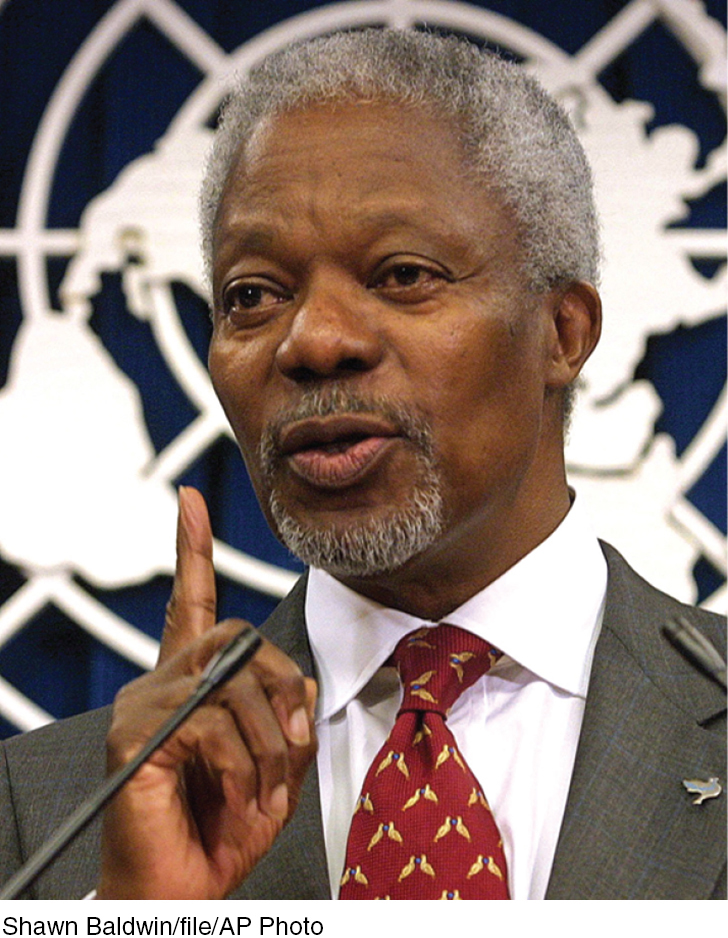37.3 Peacemaking
With astonishing speed, recent democratic movements have swept away totalitarian rule in Eastern European and Arab countries. Yet every day, the world continues to spend almost $5 billion for arms and armies—
Elements of Conflict
37-
conflict a perceived incompatibility of actions, goals, or ideas.
To a social psychologist, a conflict is a perceived incompatibility of actions, goals, or ideas. The elements of conflict are much the same, whether we are speaking of nations at war, cultural groups feuding within a society, or partners sparring in a relationship. In each situation, people become enmeshed in potentially destructive processes that can produce unwanted results. Among these processes are social traps and distorted perceptions.

social trap a situation in which the conflicting parties, by each pursuing their self-
SOCIAL TRAPS In some situations, we support our collective well-
Researchers have created mini social traps in laboratory games that require two participants to choose between pursuing their immediate self-
Social traps challenge us to reconcile our right to pursue our personal well-
mirror-image perceptions mutual views often held by conflicting people, as when each side sees itself as ethical and peaceful and views the other side as evil and aggressive.
ENEMY PERCEPTIONS Psychologists have noted that those in conflict have a curious tendency to form diabolical images of one another. These distorted images are, ironically, so similar that we call them mirror-image perceptions: As we see “them”—as untrustworthy, with evil intentions—
self-fulfilling prophecy a belief that leads to its own fulfillment.
Mirror-
Individuals and nations alike tend to see their own actions as responses to provocation, not as the causes of what happens next. Perceiving themselves as returning tit for tat, they often hit back harder, as University College London volunteers did in one experiment (Shergill et al., 2003). After feeling pressure on their own finger, they were to use a mechanical device to press on another volunteer’s finger. Although told to reciprocate with the same amount of pressure, they typically responded with about 40 percent more force than they had just experienced. Despite seeking only to respond in kind, their touches soon escalated to hard presses, much as when each child after a fight claims that “I just poked him, but he hit me harder.”
Mirror-
The point is not that truth must lie midway between two such views; one may be more accurate. The point is that enemy perceptions often form mirror images. Moreover, as enemies change, so do perceptions. In American minds and media, the “bloodthirsty, cruel, treacherous” Japanese of World War II later became our “intelligent, hardworking, self-
Promoting Peace
37-
How can we make peace? Can contact, cooperation, communication, and conciliation transform the antagonisms fed by prejudice and conflict into attitudes that promote peace? Research indicates that, in some cases, they can.
CONTACT Does it help to put two conflicting parties into close contact? It depends. Negative contact increases disliking (Barlow et al., 2012). But positive contact—
With cross-
racial contact, South Africans’ interracial attitudes have moved “into closer alignment” (Dixon et al., 2007; Finchilescu & Tredoux, 2010). Heterosexuals’ attitudes toward gay people are influenced not only by what they know but also by whom they know (Collier et al., 2012; Smith et al., 2009). In surveys, the reason people most often give for becoming more supportive of same-
sex marriage is “having friends, family, or acquaintances who are gay or lesbian” (Pew, 2013). Even indirect contact with an outgroup member (via reading a story or through a friend who has an outgroup friend) has reduced prejudice (Cameron & Rutland, 2006; Pettigrew et al., 2007).
However, contact is not always enough. In many schools, ethnic groups segregate themselves in lunchrooms, in classrooms, and elsewhere on school grounds (Alexander & Tredoux, 2010; Clack et al., 2005; Schofield, 1986). People in each group often think that they would welcome more contact with the other group, but they assume the other group does not reciprocate the wish (Richeson & Shelton, 2007). “I don’t reach out to them, because I don’t want to be rebuffed; they don’t reach out to me, because they’re just not interested.” When such mirror-
COOPERATION To see if enemies could overcome their differences, researcher Muzafer Sherif (1966) set a conflict in motion at a boys’ summer camp. He separated 22 Oklahoma City boys into two separate camp areas. Then he had the two groups compete for prizes in a series of activities. Before long, each group became intensely proud of itself and hostile to the other group’s “sneaky,” “smart-
“You cannot shake hands with a clenched fist.”
Indira Gandhi, 1971
superordinate goals shared goals that override differences among people and require their cooperation.
Sherif accomplished this by giving them superordinate goals—shared goals that could be achieved only through cooperation. When he arranged for the camp water supply to “fail,” all 22 boys had to work together to restore the water. To rent a movie in those pre-
A shared predicament likewise had a powerfully unifying effect in the weeks after the 9/11 attacks. Patriotism soared as Americans felt “we” were under attack. Gallup-

At such times, cooperation can lead people to define a new, inclusive group that dissolves their former subgroups (Dovidio & Gaertner, 1999). To accomplish this, you might seat members of two groups not on opposite sides, but alternately around a table. Give them a new, shared name. Have them work together. Then watch “us” and “them” become “we.” After 9/11, one 18-
If cooperative contact between rival group members encourages positive attitudes, might this principle bring people together in multicultural schools? Could interracial friendships replace competitive classroom situations with cooperative ones? Could cooperative learning maintain or even enhance student achievement? Experiments with adolescents from 11 countries confirm that, in each case, the answer is Yes (Roseth et al., 2008). In the classroom as in the sports arena, members of interracial groups who work together on projects typically come to feel friendly toward one another. Knowing this, thousands of teachers have made interracial cooperative learning part of their classroom experience.

The power of cooperative activity to make friends of former enemies has led psychologists to urge increased international exchange and cooperation. Some experiments have found that just imagining the shared threat of global climate change reduces international hostilities (Pyszczynski et al., 2012). From adjacent Brazilian tribes to European countries, formerly conflicting groups have managed to build interconnections, interdependence, and a shared social identity as they seek common goals (Fry, 2012). As we engage in mutually beneficial trade, as we work to protect our common destiny on this fragile planet, and as we become more aware that our hopes and fears are shared, we can transform misperceptions that feed conflict into feelings of solidarity based on common interests.
COMMUNICATION When real-
CONCILIATION Understanding and cooperative resolution are most needed, yet least likely, in times of anger or crisis (Bodenhausen et al., 1994; Tetlock, 1988). When conflicts intensify, images become more stereotyped, judgments more rigid, and communication more difficult, or even impossible. Each party is likely to threaten, coerce, or retaliate. In the weeks before the 1990 Gulf War, the first President George Bush threatened, in the full glare of publicity, to “kick Saddam’s ass.” Saddam Hussein communicated in kind, threatening to make Americans “swim in their own blood.”
GRIT Graduated and Reciprocated Initiatives in Tension-
Under such conditions, is there an alternative to war or surrender? Social psychologist Charles Osgood (1962, 1980) advocated a strategy of Graduated and Reciprocated Initiatives in Tension-Reduction, nicknamed GRIT. In applying GRIT, one side first announces its recognition of mutual interests and its intent to reduce tensions. It then initiates one or more small, conciliatory acts. Without weakening one’s retaliatory capability, this modest beginning opens the door for reciprocity by the other party. Should the enemy respond with hostility, one reciprocates in kind. But so, too, with any conciliatory response.
In laboratory experiments, small conciliatory gestures—
As working toward shared goals reminds us, we are more alike than different. Civilization advances not by conflict and cultural isolation, but by tapping the knowledge, the skills, and the arts that are each culture’s legacy to the whole human race. Thanks to cultural sharing, every modern society is enriched by a cultural mix (Sowell, 1991). We have China to thank for paper and printing and for the magnetic compass that enabled the great explorations. We have Egypt to thank for trigonometry. We have the Islamic world and India’s Hindus to thank for our Arabic numerals. While celebrating and claiming these diverse cultural legacies, we can also welcome the enrichment of today’s social diversity. We can view ourselves as instruments in a human orchestra. And we—
RETRIEVE IT
Question
What are some ways to reconcile conflicts and promote peace?